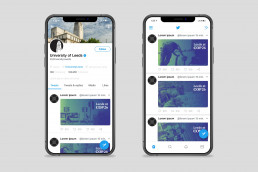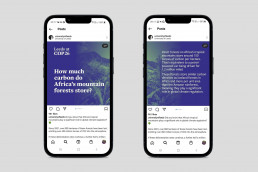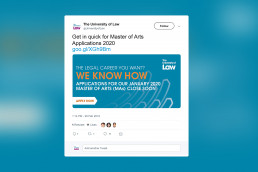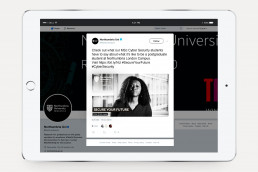With brand awareness cited as a top priority for marketers both offline and online, including social media, brand consistency is paramount. Furthermore, as of 2020 social media users now exceed 3.8 billion. Investing time and resources into building a consistent brand across social platforms and embedding this into your social media strategy is a must.
Why is Consistent Branding Important?
If your marketing strategy has worked tirelessly to cultivate the perfect brand, it goes without saying – you want this to be recognised as far and wide as possible. But actually building the brand in the first place takes consistency.
You want consumers to recognise your content, even if it’s the first time they’ve seen you on that social platform. Each interaction builds on your brand, so consistency is key for greater brand recognition. Over time, customers will recognise your posts without needing to see your logo or handle as a trigger. This is the ultimate goal of your branding strategy.
Social media marketing is often an interruption into a user’s perusal of family and friend content. The more familiar your branding is across all channels, the more comfortable people will feel with your content or in finding themselves on your page.
But how to achieve this across all social media platforms?
First of All…
Define your brand and its goals:
- Attempt to do this in concise and easily digestible wording.
- If your brand has nicknames or name variations, use the same one across all social platforms. On average, it takes a person nine visits to your company sites before making a purchase, make sure it’s the same name on each visit!
Know your target audience:
- This will impact every decision within creating brand awareness and consistency, from colour choice and tone to deciding which platforms to use.
- You can use different platforms to target different demographics (and align your content accordingly).
- Your brand message is directed at them, so get to know who they are!
Audit:
- This is relevant if you already have social media. Assess your previous content and engagement.
- Also, audit your brand across other online and offline channels.
- What is and isn’t working for you?
Decide which platforms to focus on:
- If you’re just starting out, depending on your resources, choose which social media platforms you want to focus on. Don’t spread yourself too thin. It’s far better to have one account which aces its brand elements and has an engaged following, than three half-hearted accounts.
- Think about your target audience, which platforms are they most interacting with?
How to Build a Consistent Brand on Social Media?
It’s worth emphasising that building a consistent brand is a process; it takes time and resources. You won’t see drastic engagement or sales growth overnight. But it’s worth the wait…
Much of brand consistency can be split into two basic categories, visual and written. These relate to your profiles and content.
Visual
This is arguably the most important aspect of branding (although written is by no means irrelevant!) This is because humans are highly visual, we make recollections based on visual links. Our brains have a greater ability to retain visual information than written. Here are some useful tips for creating visual brand consistency across social media platforms:
- A consistent logo that represents your brand, making it easier for those who are unfamiliar to easily understand what you’re about.
- Choose a consistent colour palette. Have these reflected in your images, graphics and videos? When someone lands on your page or scrolls passed your content, your brand will be immediately recognised. Colour also reflects emotion and purpose, so think about these when choosing your colours.
- Take your own photographs rather than using stock and maintain a consistent imagery style.
- Use a watermark on any images you publish.
- Create consistent text content too. Maintain fonts across all channels for overlays.
These tips are relevant for profile pictures, header images, event pages, social media posts, graphics and adverts, as well as your website, email marketing and blog.
You can use apps, plug-ins and programmes to store visual brand identity elements, so that every time you create content, you’re saving time. For example, you can create a graphics template for every type of post, such as an upcoming event announcement.
Written
You may already have a brand voice across other online and offline channels, it’s time to extend this to social media (if you haven’t already).
Here, knowing your brand persona is key. Are they professional, young, female, or all three? This will greatly impact the language and tone of your brand messaging and I’m sure it goes without saying now… it needs to be consistent.
If your social channels are managed by more than one person (or even if they aren’t), it’s worth creating a style guide. Anyone who speaks on behalf of the brand can refer to it, which maintains the same language and tone across content, almost as if it was one person. Include brand persona, personality traits, specific vocabulary (such as if you use the word client or customer), and any company phrases.
The important aspects to define are:
- Tone: Is it familiar, direct, or humble. Words, phrases and sentence structures make up the tone of the written word.
- Language: It could be colloquial, complex, or niche.
- Purpose: Is it your brand’s goal to sell, educate or entertain.
This will help to maintain emotional consistency within your brand, which in turn helps to increase brand awareness.
Content Re-purposing
If you do have more than one social channel an effective way to build brand awareness across your socials as a whole is to re-purpose content. As each platform is built differently and each platform’s audience differs, the way people engage with content will also differ. You need to align your content and profiles with each platform’s best practices, without losing brand consistency of course!
In essence, this means taking snippets of content, re-writing the same information, or marginally altering an image or graphics, etc. People will therefore connect the dots and recognise your brand.
For example, if you created an extended IGTV video, you could combine snippets into a shorter video for TikTok, or a slideshow on Facebook or Twitter accompanied by relevant text, perhaps something in an overlay or voice-over from the original video.
See our example for Northumbria University campaign below, created by Bell.
The more you do this across alternative channels the greater brand awareness you’ll create.
More Tips to Ace your Social Media Marketing
- Talk like a human. Use conversational dialogue rather than corporate. This helps to make your brand more relatable and personal.
- Interact with your following. Reply to messages and comments creating an authentic two-sided relationship. This creates trust.
- Post relevant content (think about your brand personas again here!)
- FREQUENCY IS KEY! Post regularly and frequently. Draw up a social media schedule and stick to it. If you’re not visible, you’re not building brand recognition. This task can seem daunting, especially knowing that other brands have entire social media teams at their disposal. If you’d like to increase your social media presence but just don’t have the time, get in touch with our social media experts at Bell today.
If you implement these actions within your brand strategy, you’ll improve consistency and awareness, and demonstrate your brand personality, all of which will help you to connect with your target audience. This strategy can be applied to all online channels including your website, blog and email marketing.
To enquire about content strategy and social media, get in touch with our team at Bell.










